Processing food waste at large scales
In New Zealand, many cities are faced with significant volumes of food waste thrown away by households and businesses alike. At the moment, only 12 city and district councils collect food scraps separately from general waste. However, many more are planning to roll out kerbside food scraps collection services, and the government might make this mandatory for councils in the coming years.
Mapping kerbside collection by territorial authority
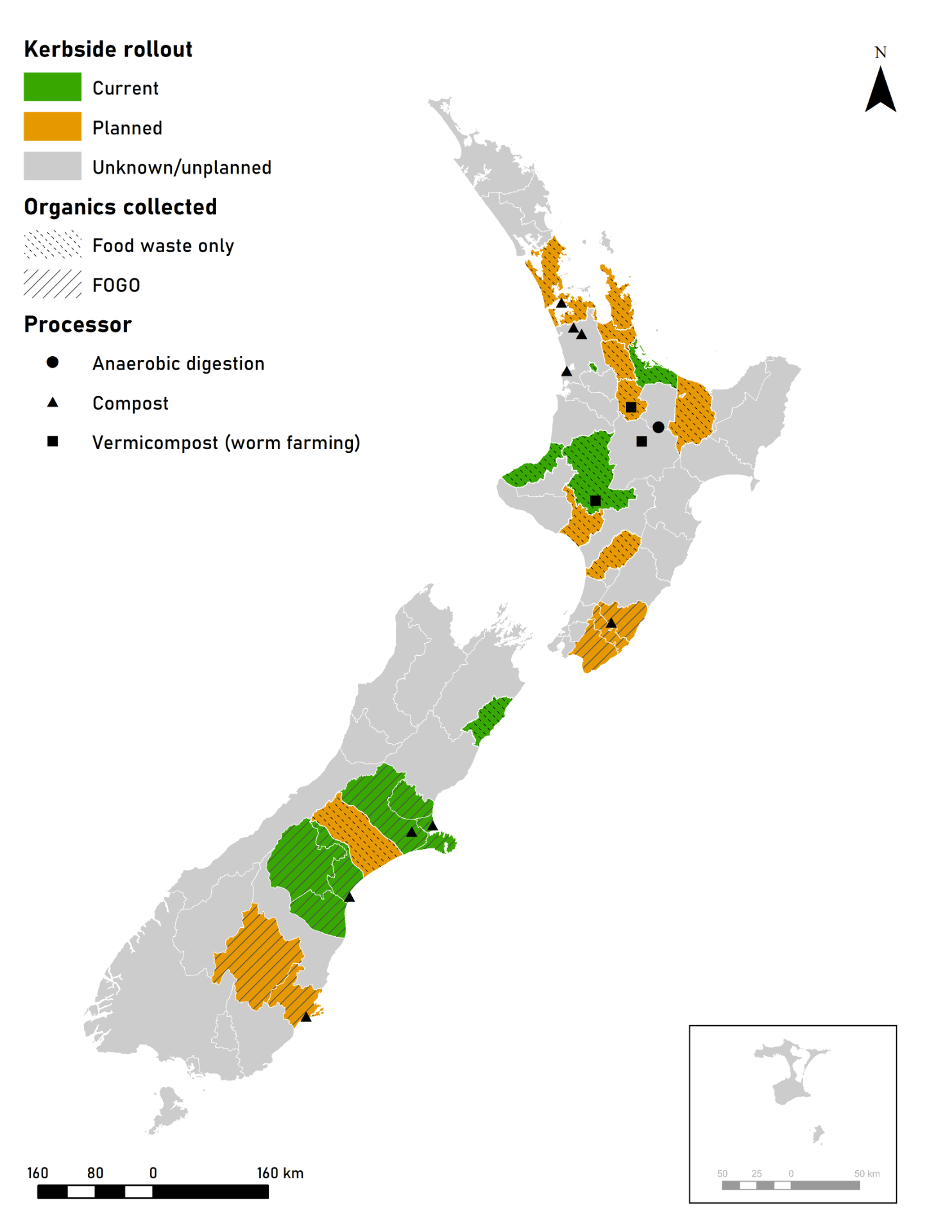
The status of kerbside food waste collection among New Zealand’s territorial authorities (TAs), showing current (green), planned (orange), and unknown/unplanned (grey) collection services. Importantly, TA plans for waste collection services are continually evolving, whereas this map represents a single point in time (data were last updated in early 2023). For territorial authorities with current and planned food waste collections, food waste is either collected in a standalone bin (stippling) or as Food Organics and Garden Organics (FOGO), where food waste is mixed with green waste (stripes). The map also shows large-scale, centralised facilities listed by the Ministry for the Environment and territorial authorities as existing or potential food waste processing sites. Map inset shows the Chatham Islands.
For those councils currently offering kerbside food waste collection, composting is the dominant processing method, although in some regions worm farming is used to process business food scraps. However, in a new initiative, Auckland Council will be sending its food scraps – an estimated 38,000 tonnes per year – to a new EcoGas anaerobic digestion plant in Reporoa as it rolls out kerbside collections across 2023, following trials in Papakura and selected streets in North Shore suburbs.
The range of large-scale, industrial processing options for kerbside food scraps that are canvassed below can complement the home-based and community-based solutions, which can also be invested in by councils and agencies keen to support place-based solutions and embed social procurement into their practices.
A risk for large-scale commercial operations is that their profitability can be contingent on a continual or increasing supply of food waste, which may not be possible if food waste prevention efforts are successful, so thought needs to be given to off-ramps.
Take a look at how Tauranga’s kerbside food scraps get turned into nutrient-rich compost. As well as providing an overview of how centralised, large-scale composting works, the video clip highlights that residents are still getting used to what can and can’t go into their bins. Keeping contaminants out is crucial, with much of the compost being used to grow avocados and kiwifruit in the region.
Many of the processing options listed below can be used to process organic waste streams other than food waste, such as biosolids, manure, or forestry waste. Importantly, the quality of what goes into each process will dictate the quality of what comes out, with contaminants like heavy metals, microplastics, and ‘forever-chemicals’ being particularly difficult to manage. Thus, controlling inputs is a key part of the process, as no process provides a silver bullet to contaminant-heavy streams of waste.
There are other processing options beyond those covered below, but these generally have niche applications or low technological readiness so aren’t included here. A wider range of food waste processing options will be covered in the OPMCSA food waste reports.
Conversion to animal feed
How does it work?
If spare food can’t be rescued or upcycled to feed to people, it can often be fed to animals, preferably as part of a balanced diet. In accordance with government regulations, food waste can be fed to animals, either directly or after processing. This is a long-established practice, occurring in Aotearoa at small scales (e.g. cafés collecting food scraps for a local farmer) and at an industrial scale (e.g. Eco Stock). While the animal feed industry already utilises surplus food and food system by-products, feeding mixed household food scraps to animals at scale isn’t currently practiced in Aotearoa. Animal nutrition and disease transmission risks are crucial factors to think about when feeding food waste to animals.
Animal feed conversion: inputs, process, outputs
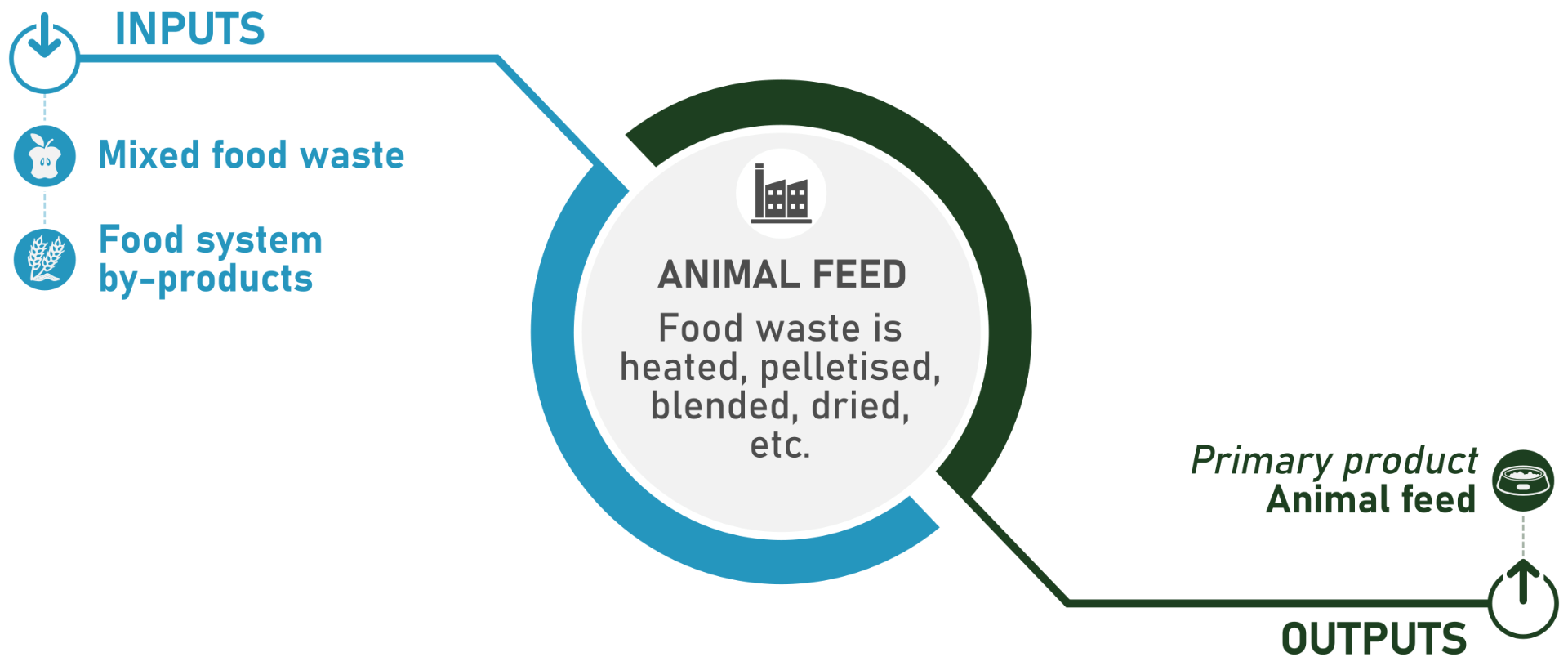
Infographic showing the main inputs and outputs involved with converting food waste to animal feed. Conversion to animal feed is a diverse process, depending on the type of feed being produced and the inputs involved. For example, it can be as simple as feeding plant-based food scraps directly to pigs or chickens or may involve heat treatment of food waste that might contain animal products. Food waste may be dried, added to pellets, converted to a slurry, or otherwise processed before feeding.
Key benefits
- Can reduce competition for resources with human food production and decrease the environmental footprint of existing agricultural systems.
- Has the potential to positively impact the price of food by bringing down production costs for farmers.
- Reduces the need to import animal feeds, reducing feed system transport emissions and increasing the resilience of our domestic agricultural systems.
Key challenges and risks to mitigate
- Utilising mixed household or business food waste can pose disease transmission risks, especially if meat is present in the food waste. Strict controls and regulatory compliance, especially heat-treating food waste that contains meat or has been in contact with meat products, and ensuring ruminants don’t eat ruminant-containing food waste, can reduce this risk.
- Food waste streams aren’t optimised for animal nutrition, and some argue that it isn’t transformational enough, embedding animal-based agricultural systems. Balancing food waste with other feeds and being specific about the kinds of food waste accepted can help. Using insect intermediaries also mitigate these concerns.
Case study: Food waste to animal feed in Aotearoa
Food waste is transformed to animal feed by a number of companies in Aotearoa, including Ecostock, Castlegate James, and Takanini Feeds, which produce feed for the agricultural sector, and Omega Plus and United Fisheries, which produces treats and dietary supplements for pets. Direct relationships between food businesses and local farmers is another pathway from food waste to animal feed, and households often feed scraps to their pets too.
For animal feed businesses in Aotearoa, feedstocks, processes, and products vary. Overall, there is a focus on production of animal feeds from homogenous, pre-consumer food waste streams, rather than mixed household or food service food wastes. This focus is driven by the need to minimise potential disease transmission, comparative ease of process control and increased certainty around feed safety and nutritional properties that comes from knowing exactly what is going into the feed.
Ecostock, for example, specialises in de-packaging manufactured food products at risk of going to waste and converting them into food waste blends to be used in stock feed. Castlegate James and Takanini Feeds, meanwhile, produce finished feed products, combining food waste-derived ingredients such as biscuit meal and brewers’ grain with other ingredients, making feed mixes and pellets. Across Australia and New Zealand, Castlegate James converts 700,000 tonnes of food at risk of going to waste to animal feed every year. Commercial fisheries in Aotearoa convert by-products (e.g. offal) to fish meal, which can be used as feed for chickens, pigs, and farmed fish. Omega Plus demonstrates how more financial value can be gained from animal feed conversion of fisheries by-products by catering for the premium pet food market, as do United Fisheries in making mussel-based nutritional tablets for pets.
Opportunities to convert inedible and unpreventable food waste streams to animal feed continue to be explored in Aotearoa, such as use of milk processing waste, crop residues, and grape marc as feed components.
Another less-explored avenue is conversion of mixed household and food service food waste to animal feed. The main concerns associated with using post-consumer mixed food waste as animal feed relate to nutrition, transmissible spongiform encephalopathy risks, pathogen transmission, and chemical contaminants. Commercial feed manufacturers have the required processes to comply with biosecurity regulations and apply adequate heat treatment which negates pathogen risks, and nutritional needs of animals can be met with food waste-derived feeds, especially when they are used as part of a wider diet programme. However, current food waste treatment technologies may not eliminate the risk of diseases like mad cow disease (a transmissible spongiform encephalopathy disease) caused by transmissible proteins able to move between animals and humans in the food supply chain. In addition, some chemical contaminants, if present in the food waste feedstock, may accumulate in animal feed. New Zealand’s animal feed rules ban the use of ruminant protein in feed for ruminants given the risk of transmissible spongiform encephalopathy spread, which would mean that any animal feed derived from mixed household food waste wouldn’t be suitable for ruminant animals if it might contain meat.
Insect-based bioconversion
How does it work?
Food waste is fed to insects and the insect larvae are used as animal feed. The larvae, which are rich in protein and fat, are often dried, milled, or otherwise processed before being fed to animals. Extracted larvae oil could also be used as a biodiesel, and one day people might eat insects raised on food waste, although food safety risks would have to be managed and the ‘ick factor’ would have to be overcome.
While there are clear end markets for the larvae, they leave behind a mixture of frass (i.e. insect poo), undigested residual food waste, and exoskeletons. This could be used as a soil conditioner (either as it is or after further processing, e.g. composting), but further research is needed to understand its performance and possible risks.
Insect-based bioconversion isn’t currently practiced in Aotearoa but is starting to be explored. It is a growth industry in Australia and other parts of the world.
Learn about insect bioconversion using black soldier flies in this teaching module produced by two Swiss research institutes. The exact set up of commercial black soldier fly farms varies; this video illustrates just one example of how a fly farm could be run.
Insect-based bioconversion: inputs, process, outputs
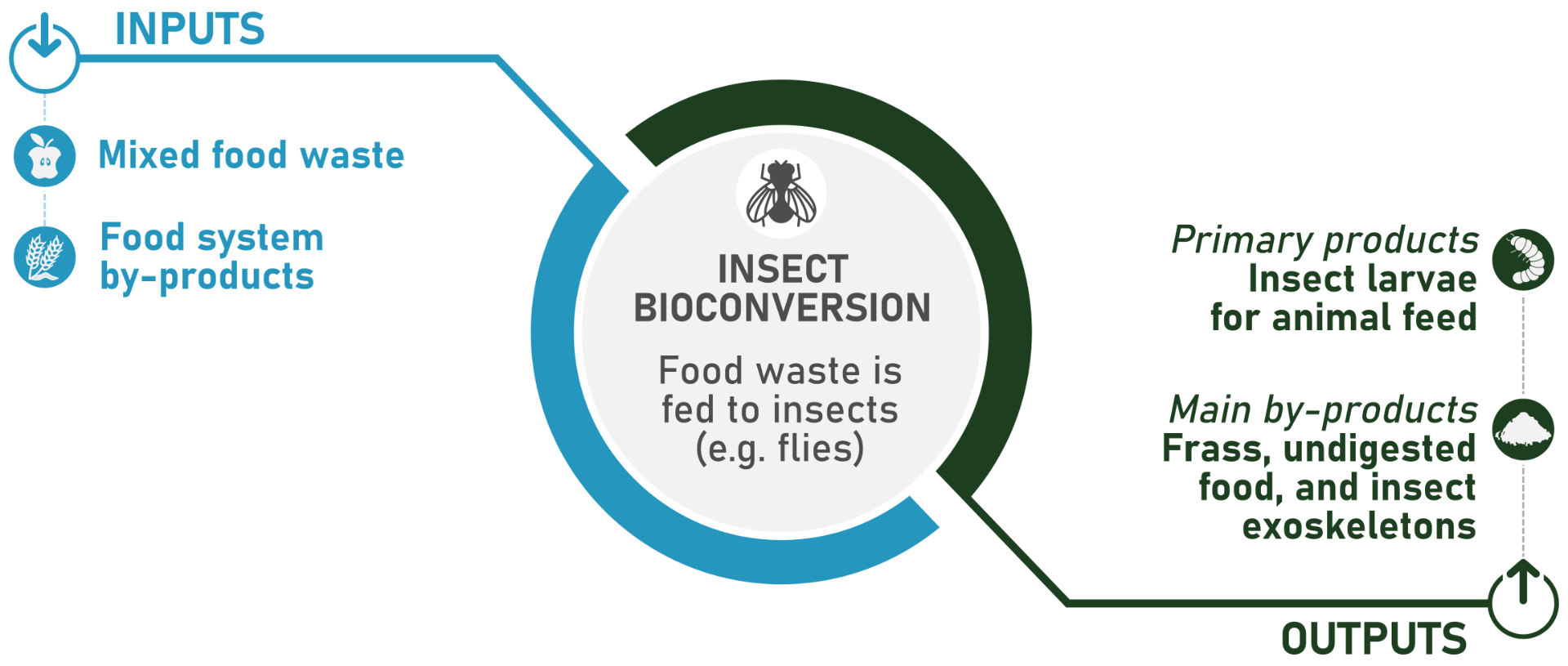
Infographic showing the main inputs and outputs of insect bioconversion, a food waste processing option which uses insects as an intermediary to convert food waste into a more nutritionally consistent animal feed. If inputs are restricted to food system by-products such as spent brewers’ grain or vegetable trimmings, the process can be tightly controlled, and potential sources of contamination excluded. Where mixed food waste is used as an input, it is crucial to understand what happens to potential biological (e.g. bacteria, viruses) and chemical (e.g. pharmaceuticals, toxins) contaminates. The main by-product, frass, has the potential to be used as a fertiliser either directly or with further processing.
Key benefits
- If insects replace other protein-rich animal feeds, this food waste processing option can have a substantially positive impact on greenhouse gas emissions, reducing emissions from the feed production industry by using food waste as a resource instead of growing animal feed anew. This emissions benefit far outweighs any electricity-associated emissions, which can be quite high (e.g. for lighting, temperature regulation).
- Feeding food waste directly to animals can make it hard for farmers to ensure their animals are eating a nutritionally balanced diet for optimised productivity and wellbeing. Using waste-fed larvae instead helps to overcome this challenge.
- Selective breeding programmes can be used to increase the efficiency of bioconversion, meaning that more of the nutrient and energy content in the food waste is converted to insect larvae for animal feed.
- Compared to feeding untreated food waste to animals, bacterial, viral, and parasite and other risks are reduced when food waste passes through the insects (e.g. viruses which are evolved to infect mammals can’t readily replicate in insects) and can be further mitigated by managing the food waste streams that go into the process and by rinsing, blanching, and drying the larvae.
Key challenges and risks to mitigate
- Inconsistent waste streams (e.g. mixed household food waste) can make process and product management hard – the insects will develop differently with variations in the food waste they are raised on meaning that not all batches of insect larvae will be the same, and process variations might be needed.
- If there are contaminants in the food waste, some are broken down by the insects (e.g. some organic pollutants, toxins, pesticides, and pharmaceuticals), but others (e.g. heavy metals) may either be taken up by the insects or end up in the frass mixture, creating possible health risks for the animals that eat the larvae or soils where frass is applied, and food derived from them. These risks are best managed by tight control over inputs.
Case study: Converting food waste to animal feed at FlyFarm in Brisbane
FlyFarm is a growing agri-tech business focusing on developing highly automated black soldier fly (Hermitia illucens) larvae farms that convert organic waste into high quality protein for animal feeds. Insect frass is also produced during bioconversion, which FlyFarm is trialling as a fertiliser.
The company is headquartered in Singapore and has a presence in Hong Kong, Taiwan, and Brisbane. The Brisbane team runs a pilot plant, recently expanded and fitted with robotic handlers, environmental sensors, and software control mechanical shifters, enabling much of the vertical insect farm to be automated.
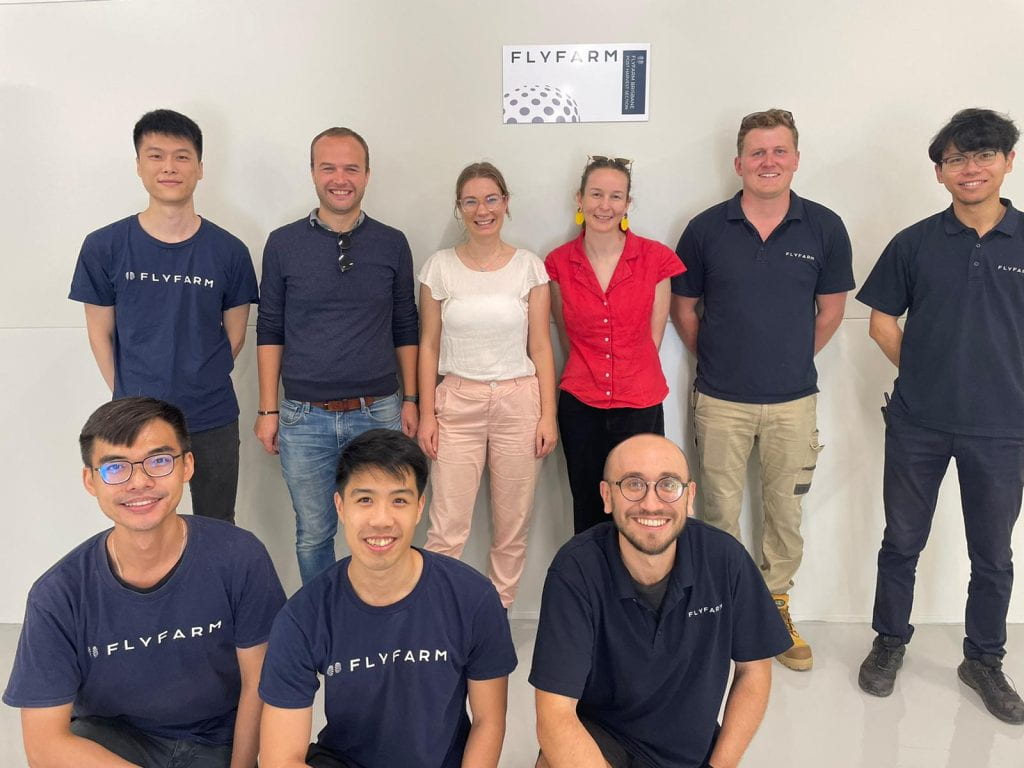
OPMCSA and Fight Food Waste Cooperative Research Centre visiting FlyFarm, hosted by co-Founder Andres Crabbe,
Queensland FlyFarm manager Oliver Warcup, and entomologist Chen Wu, alongside the FlyFarm robotics team.
FlyFarm is focused on producing high quality outputs so currently processes homogenous plant-based food waste (e.g. brewers’ grain) rather than mixed waste to avoid contamination of the larvae or frass.
The process begins with adult black soldier flies, which are raised in mosquito net enclosures where they lay eggs. Because black soldier flies are most active during the day, they are kept under UV light to stimulate activity.
The larvae are put into trays and introduced to a soy by-product initially, before being fed on the primary food waste stream, which usually must be ground into small particles to optimise bioconversion. Over the course of 9–11 days, the larvae consume the food waste. FlyFarm works to minimise the residual food waste remaining, so the trays mostly contain larvae and frass at the end of this time.
The larvae are sifted from the frass and blanched and dried before bio-oil is extracted from them (‘defatting’). The protein-rich dried larvae can then be powdered, and the bio-oil and powder (along with other ingredients) can be combined in ratios that meet the nutritional needs of different animals and operational requirements of farmers. This post-processing also stabilises the larvae, giving them a long shelf life, while a live larvae product would have to be used more rapidly (although is offered by some bioconversion businesses, e.g. for captive reptiles). A small number of larvae are kept, maturing into adult flies to repeat the process. When adult flies die, some are combined into an attractant mixture that is used to get live flies to lay their eggs in a collection substrate, while the rest (which have a small total mass) go to waste. FlyFarm intends to explore ways to purify chitin from dead flies and pupae shells in the future (chitin has a range of applications, e.g. as a food additive or emulsifier).
The frass contains nutrients with fertiliser value. It can be further processed (e.g. by composting) or applied directly to fields. FlyFarm is trialling direct application of its frass with a local strawberry grower.
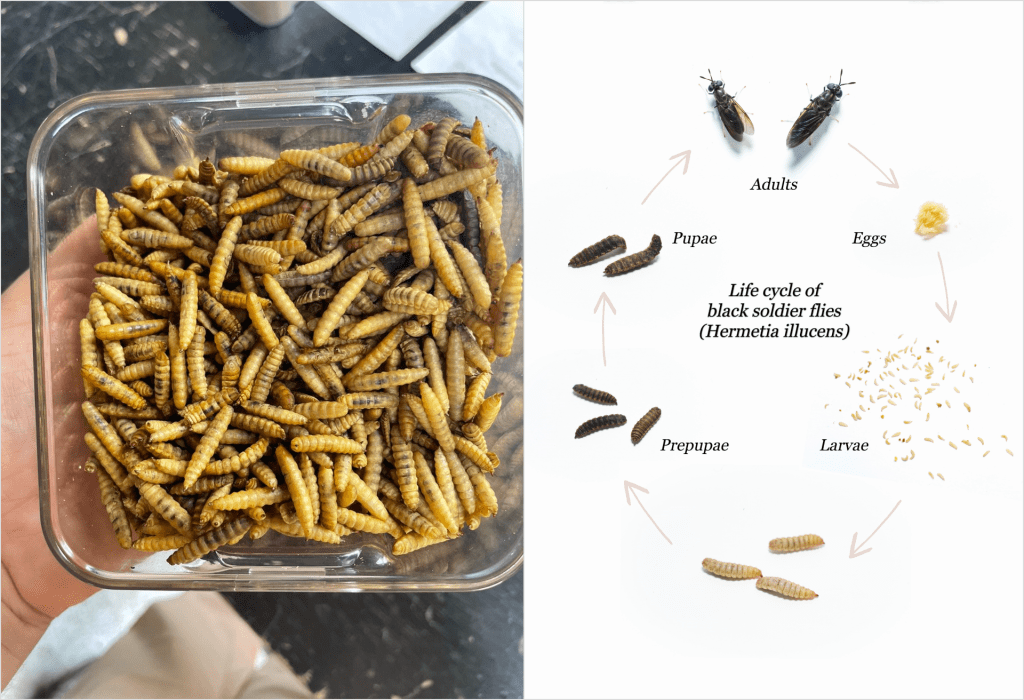
Left to right: Dried larvae produced at FlyFarm; Black soldier fly (Hermitia illucens) lifecycle. Image credit: Chen Wu, FlyFarm.
FlyFarm’s ideal operating model involves partnership with food waste owners, co-locating bioconversion infrastructure at a food processing or manufacturing facility and valorising their waste onsite. FlyFarm has multiple revenue streams – including food waste handling fees, larvae product sales, and frass product sales, and are looking to verify the greenhouse gas emissions benefits of their work so that they can sell carbon credits on voluntary markets.
When establishing in Australia, FlyFarm faced few regulatory barriers as black soldier flies were already reared commercially there, and the species is found globally and not considered to be an invasive species. Focusing on homogenous, plant-based food waste also eases regulatory barriers.
FlyFarm is continuing to refine its processes and undertakes research into a range of topics including selective breeding for flies that efficiently convert food waste, the fate of contaminants during the bioconversion process, and the performance of frass as fertiliser.
Composting
How does it work?
Food waste is combined with garden waste and other carbon sources and then, if the mixture is sufficiently aerated, broken down by microbes in the presence of oxygen. The resulting compost can be used as a soil amendment, returning nutrients and carbon to the land.
Composting can take many forms, from familiar backyard bins, to windrows, turned piles, aerated static piles, and to enclosed and in-vessel systems. In some cases, specific microbe formulations can be added in to optimise the process and reduce the need for turning.
Composting and the use of compost in landscaping, gardening, and agriculture is established, with well-understood soil fertility benefits. In Aotearoa, composting takes place at the home, within communities, and at large-scale, centralised facilities.
Learn about different composting technologies in this teaching module produced by two Swiss research institutes. Note, the examples shown in this video are context-specific; composting operations around the world will all look slightly different.
Composting: inputs, process, outputs
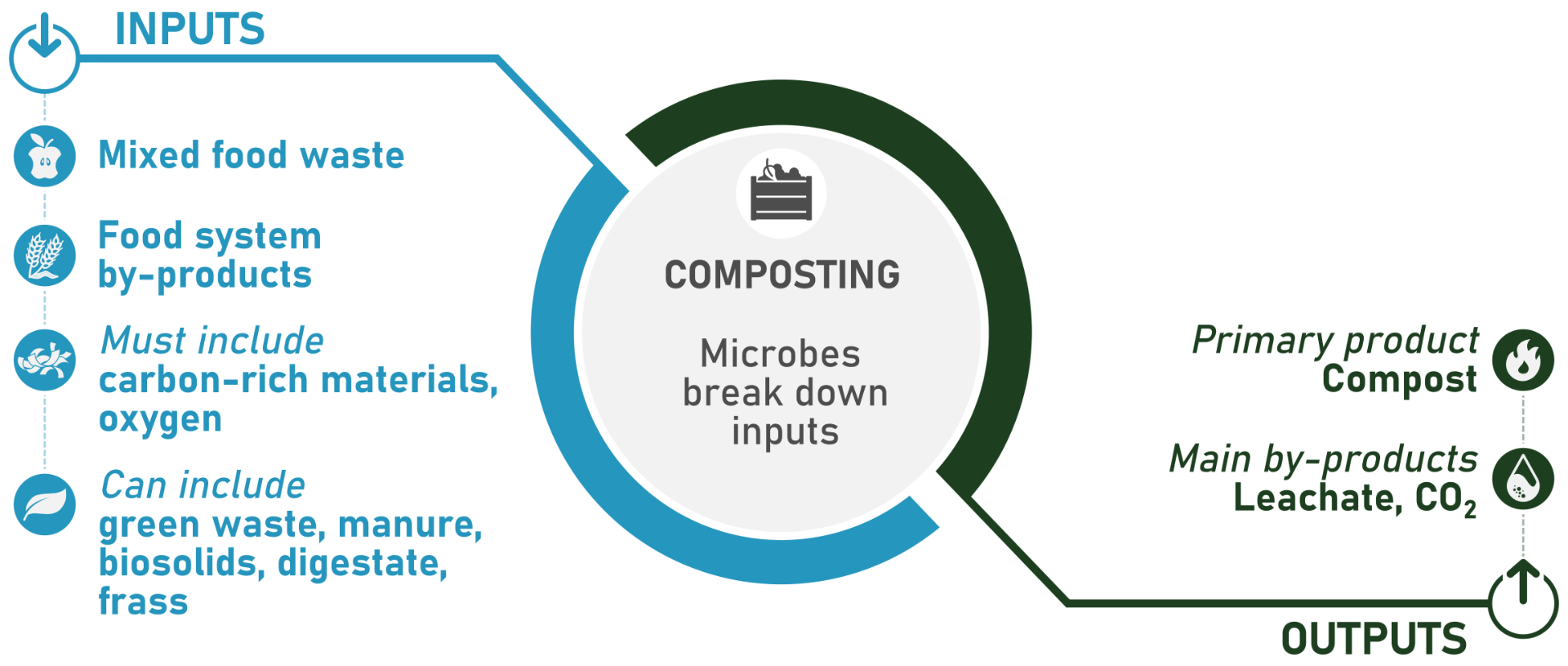
Infographic showing the main inputs and outputs of composting, a food waste processing option that can be applied in the home, community, or by large-scale, centralised enterprises. Food waste and by-products need to be combined with carbon-rich materials to get the ratio of nitrogen and carbon right, and compost piles need to be kept aerated (e.g. by turning) to keep methane production as low as possible. The resulting compost contains nutrients that can be added back to soils. The process also generates CO2 and can produce leachate, although the latter can be minimised through good management practices.
Key benefits
- Relatively simple process that can be scaled up or down depending on volume of food waste.
- Compost is generally rich in organic matter, nutrients, and microbes which contribute to soil ecosystems. The composting process also reduces the volume and weight of the initial organic weight.
- Compost can build soil carbon and reduce the need for fertiliser. When the process is done effectively and carbon sequestration and displacement of synthetic fertiliser are factored in, emissions from composting can be close to or better than net zero.
- When undertaken within communities, whether it be at home, compost clubs, or social enterprises, composting provides a range of broader social and environmental benefits, such as facilitating community connections, supporting urban agriculture, and promoting broader food waste awareness and sustainability initiatives, and creates ‘small circles’ in the circular economy.
- While animal products can’t readily be composted at home, large-scale centralised composters generally accept these types of food waste and are able to produce quality-controlled outputs.
Key challenges and risks to mitigate
- If managed poorly, leachate, odour, pests, and greenhouse gas emissions can become an issue (including methane, which will always be produced in small amounts but can be produced in large amounts if the pile isn’t sufficiently aerated).
- Sufficient garden waste and other carbon-rich material must be sourced and layered with food waste to balance the ratio of nitrogen (from food) and carbon, while additional water may be needed to maintain moisture content in composting material (especially in summer months in outdoor operations).
- Different composters have different abilities and willingness to accept and process biodegradable and compostable products. These products can be a source of contamination (e.g. microplastics, chemicals including PFAS) in compost.
Case study: Living Earth, New Zealand's largest compost operator
Living Earth is a New Zealand-based composting business owned by Waste Management. Living Earth has been in operation for more than 20 years, with primary sites in Christchurch and Auckland, and is New Zealand’s largest organic waste to compost operator. Annually, Living Earth’s composting facilities can process over 100,000 tonnes of garden and food waste, turning it into compost. Compost is sold as a soil amendment, used by gardeners, farmers, and landscapers to improve the fertility, structure, and water retention of their soils.
Living Earth’s composting operations differ between its two sites. At its Organics Processing Plant in Bromley, Christchurch, Living Earth composts 60,000 tonnes of mixed garden waste and food waste annually in 18 in-vessel composting tunnels, generally at a carbon-to-nitrogen ratio of 30:1. Much of this waste is collected from households in Christchurch, as part of the city’s organics kerbside collections. Once organic material is shredded, it is placed in windrow tunnels for 2–3 weeks before being moved outdoors and offsite for maturation to manage odour. During maturation, organic material is broken down by microbes over the course of 2–3 months. During this process, the microbes are kept active and efficient by ensuring that air, temperature, and moisture levels remain consistent within composting material by mechanically turning the windrows and adding water as needed during summer months. Water runoff from the windrows is managed using a pond system. Typically, composting material at Living Earth sits at 50–60°C (a result of the metabolic process of microbes), temperatures which help kill off pathogens and weed seeds in the organic material. Compost from the Bromley site is primarily sold in bulk to farmers in the Canterbury region, as well as local gardeners and Christchurch City Council for restoration projects.
In Auckland, Living Earth runs an outdoor windrow composting system on Puketutu Island, a site which spans 12 hectares (eight of which are currently used for open-air composting, with 4 hectares set aside for potential expansion). At its Puketutu site, Living Earth processes 30,000 tonnes of green waste annually, sourced from yard trimmings and plant material, primarily from waste transfers stations and residential collections. It takes microbes 3–4 months to break down green waste and convert it into compost. As composting operations at Puketutu are outdoors, up to 200 cubic meters of water is added to windrows per day in summer months to maintain moisture content in windrows. Water and leachate runoff is diverted to large storage ponds. Once compost at Puketutu has fully matured, it is mixed with angular sand, pumice, and aged bark to improve its properties as a soil amendment product. This compost product is primarily sold into the Auckland urban landscape market, both in bulk and in bags, as well as to infrastructure projects in and around the region.
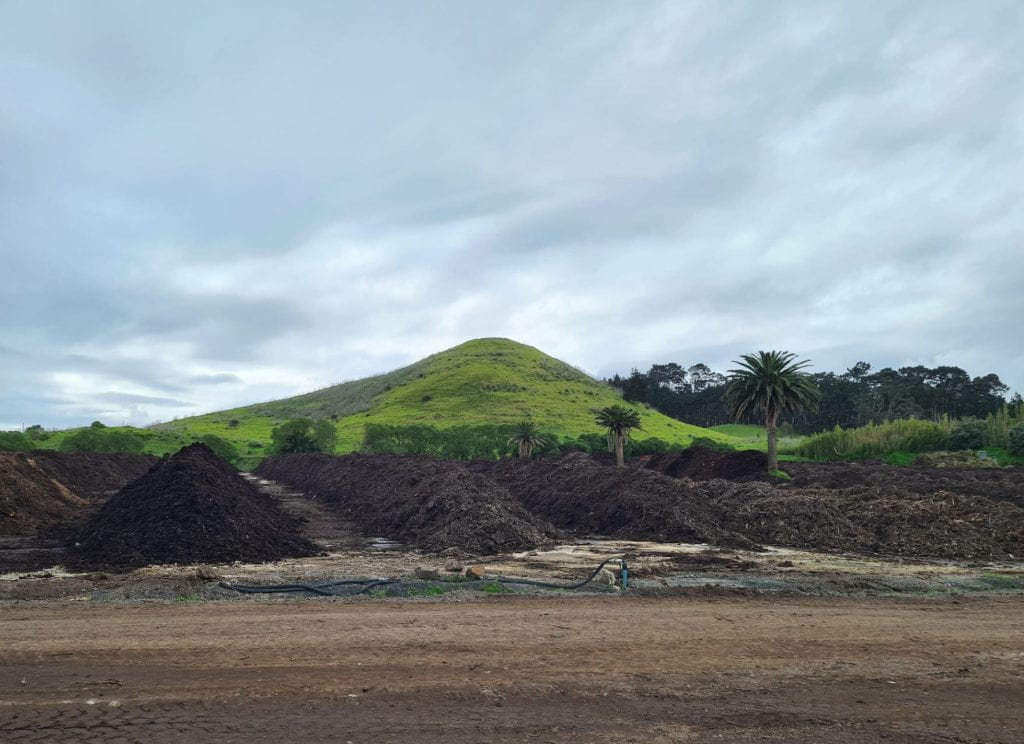
Windrows of composting material at Living Earth’s site on Puketutu Island
Compost sold from both of Living Earth’s facilities meet voluntary New Zealand standards for compost, soil conditioners and mulches, while some of their products are certified for use in organic production by BioGro or AssureQuality.
Living Earth works to mitigate several challenges which often affect large-scale composting. For example, micro-contaminants, including heavy metals and herbicides like clopyralid, can reduce the quality of compost. At Living Earth, batches of compost are tested regularly on- and offsite for micro- and macro-contaminants, nutrient value, maturity, and growth performance. During the composting process, Living Earth also monitor and control process parameters, especially temperature, moisture, and oxygen. This ensures that compost undergoes pasteurisation and prevents windrows from becoming anaerobic and producing methane.
Living Earth currently employs 13 staff in Auckland and 18 in Christchurch. Beyond its business activities, Living Earth sponsors a restoration project on Motutapu island and supports a number of community initiatives.
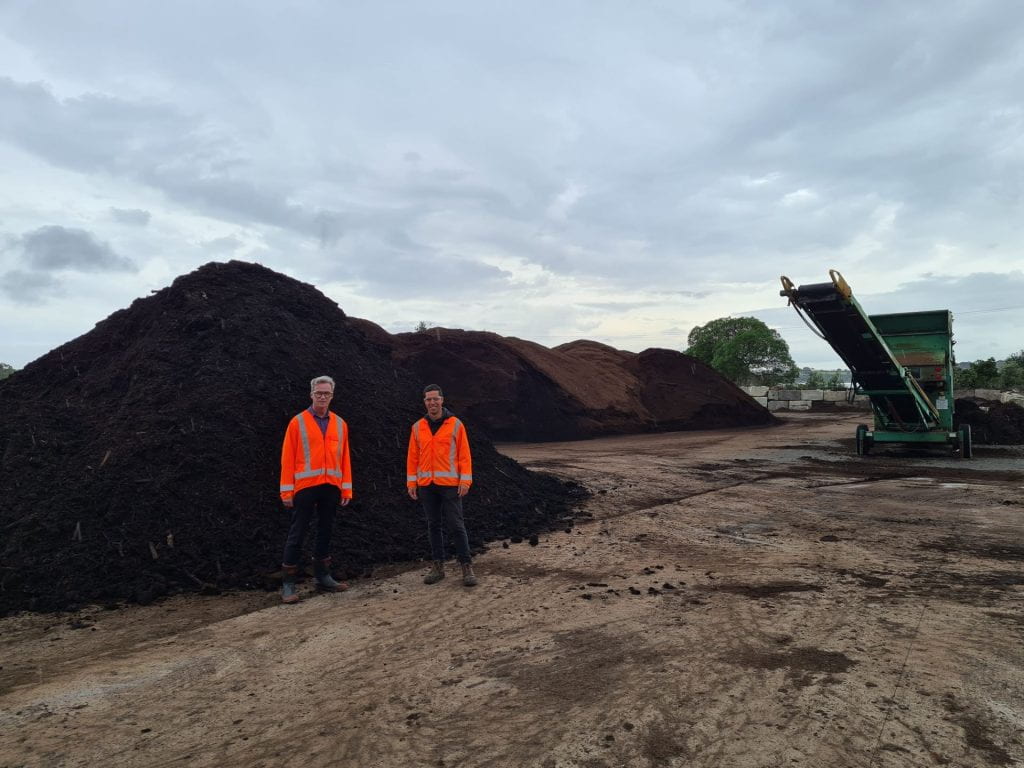
OPMCSA’s George Slim (left) and Living Earth’s Logan Dingle (right) stand in front of piles of mature compost ready for market.
A compost screening machine stands to their right.
Vermicomposting (worm farming)
How does it work?
Food waste is eaten by worms, producing a product called vermicast which improves soil. Vermicomposting can be undertaken using closed vessels or in windrows.
Vermicomposting is well-established in Aotearoa, with one large-scale enterprise and many people engaging in vermicomposting – commonly known as worm farming – in their communities and homes.
Vermicomposting: inputs, process, outputs
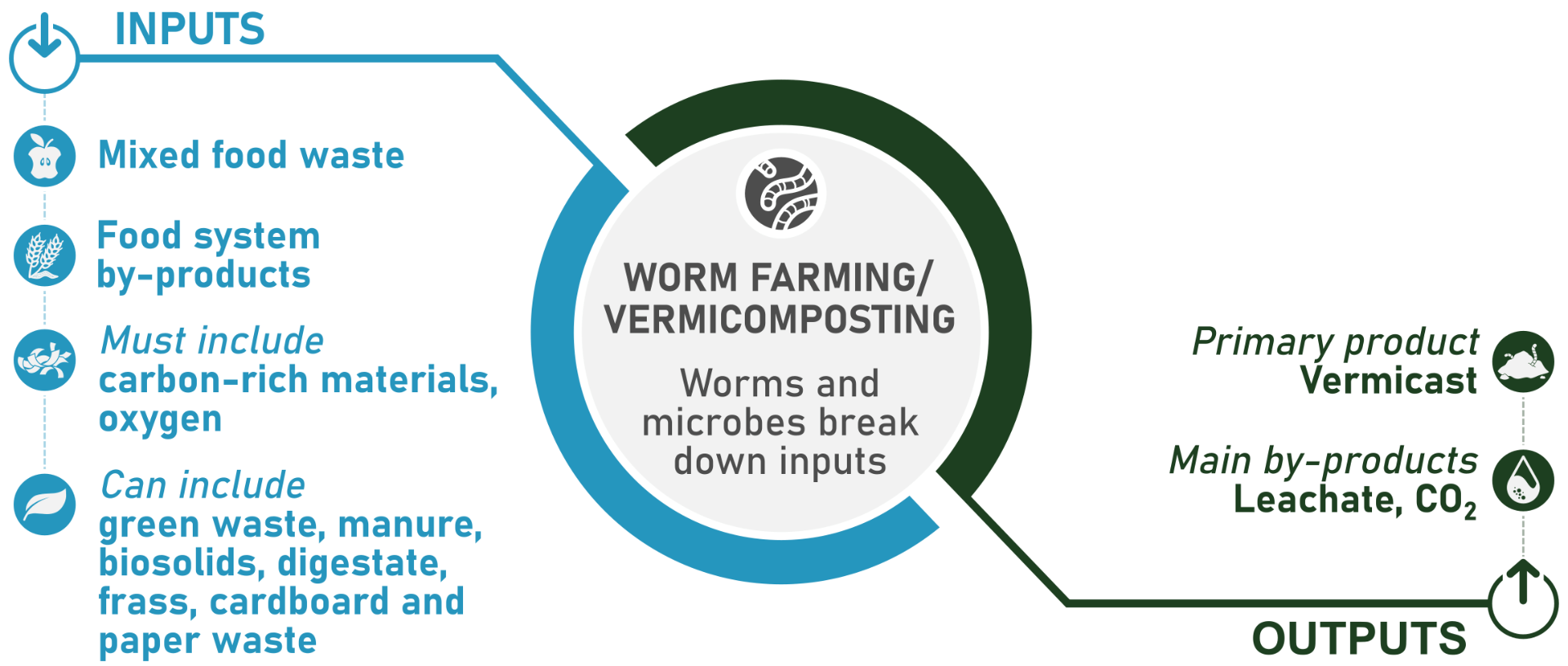
Infographic showing the main inputs and outputs of vermicomposting, a food waste processing option that can be applied in the home, community, or by large-scale, centralised enterprises. Fibrous material needs to be added to food waste inputs, and oxygen is crucial too, although the worms themselves incorporate it to the process so no active aeration is needed. The main product is vermicast, which can be used as a fertiliser. The process also generates CO2 and can produce leachate, although the latter can be minimised through good management practices.
Key benefits
- Similar or slightly lower emissions profile when compared with composting, including with carbon sequestration and fertiliser displacement benefits.
- Vermicast is typically a stable, nutrient-rich substance which can be used as a soil conditioner. The vermicomposting process also reduces the volume and weight of initial organic waste.
- Unlike composting, no pile turning is required to keep the system aerobic – the worms do this work themselves, reducing labour and processing emissions (if compost turning is done by machine).
- Can process a wide variety of inputs, including mixed food waste, biosolids, digestate from anaerobic digestion, and industrial effluent.
- Pathogens such as aerobic bacteria, viruses, and fungi found in organic waste are broken down as they pass through the digestive system of worms.
Key challenges and risks to mitigate
- Need to manage the process and design facilities to avoid leachate (e.g. windrow rotation across farmland, maintaining the correct carbon to nitrogen ratio).
- There is less literature on the emissions profile of vermicomposting than for compost, making comparative emissions-based assessments of this food waste processing approach challenging.
- As with composting, biodegradable and compostable packaging can be a source of contaminants.
- As vermicomposting is not a thermophilic process (it doesn’t get hotter than about 35°C), vermicast may need to be pasteurised to produce a seed-free product and remove any pathogens which are unaffected by worms’ digestive systems.
Case study: The team of three billion at Mynoke
MyNoke is a New Zealand-based vermicomposting business that uses earthworms to process dairy waste residues, food waste, paper and cardboard waste and wastewater sludge, wood ash and other feedstocks at multiple sites across the North Island. MyNoke was started by soil-scientist Michael Quintern in 2007 and today has sites in Ohakune, Taupō, and Tokoroa. Across these sites, MyNoke estimates some three billion worms eat 160,000 tonnes of organic waste annually, converting it into vermicast. Vermicast is primarily used as a soil conditioner to improve fertiliser efficiency and substitute some synthetic fertiliser.
To produce vermicast, trucks collect various organic waste from customers and unload it onto concrete slabs at MyNoke’s vermicomposting sites. Here, the waste is sorted to remove contaminants such as plastic, glass, wood, and plastic lined cups. Organic waste is then mixed with fibrous, carbon-rich materials (e.g. newspaper, egg cartons, sawdust, or cardboard) and laid out on fields in long piles (called windrows) using agricultural machinery. The first of these windrows are seeded with worms (typically Eisenia fetida and Eisenia andrei). As the worms eat their way through waste, they reduce its volume up to 80% and leave behind vermicast. In addition, worms keep the windrows aerated as the move through the pile, helping soil microbes to break down waste further. Once the worms have eaten through the organic waste in one windrow, they migrate to the next windrow in line. A single windrow, which can contain more than 100 tonnes of organic waste, is typically processed by worms and soil microbes within 9–12 months. Vermicast is harvested from windrows annually and is mechanically screened to remove remaining physical contaminants like stones and plastic.
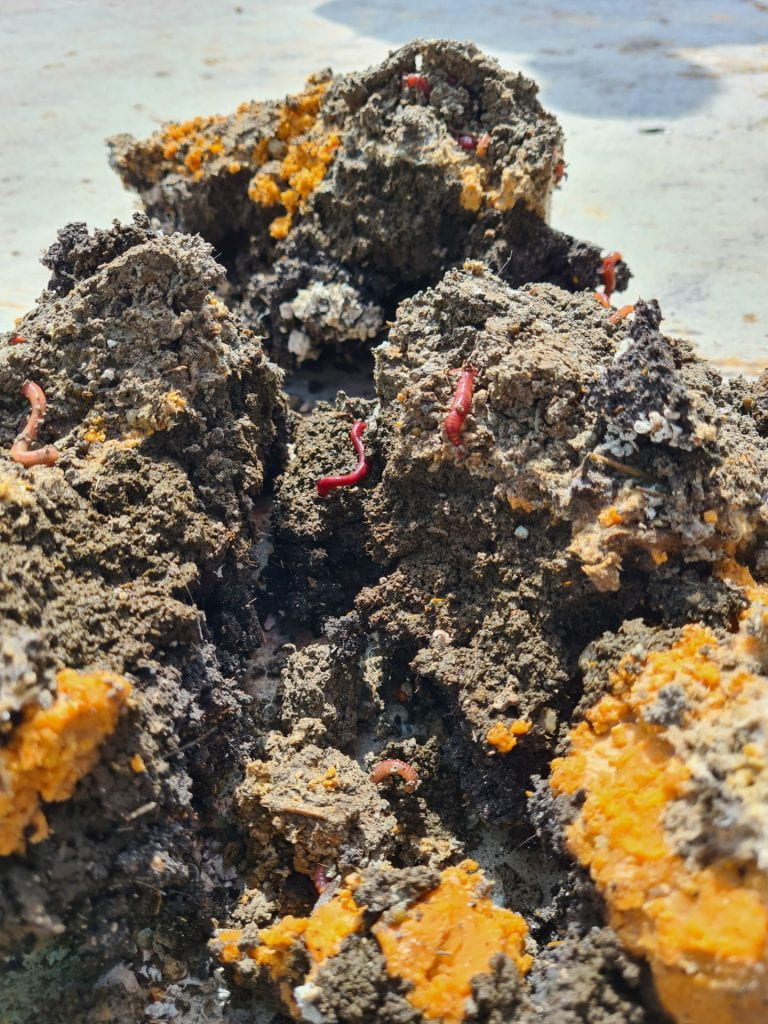
Earthworms are put into a mixed feedstock of biosolids (black and dark brown material), dairy wastes (orange),
and paper pulp (grey) on the concrete slab where MyNoke mixes their inputs. Feedstock mixes like this
are subsequently laid out in large windrows on fields.
The nutrient content of vermicast depends on the feedstock used, but vermicast generally contains high amounts of water-soluble nutrients like nitrogen and phosphorous. Earthworms can remove pathogens (e.g., fungi, aerobic bacteria, and viruses) as they consume organic waste, and vermicast can be further pasteurised using geothermal heat to kill off weed seeds. Unlike composting, windrows do not reach high temperatures, instead maintaining temperatures below 35°C. A benefit of the lower temperature is that it reduces odour emissions from windrows. To protect soils, Mynoke rotates the location of its windrows across paddocks to mitigate soil compaction and prevent the accumulation of excess nutrients.
The majority of MyNoke’s vermicast is sold in bulk to farmers and orchards in Aotearoa, with a smaller share sold to retailers as packaged product for home gardeners. Although vermicast sold to New Zealand markets is not pasteurised, it meets the voluntary New Zealand standard for compost, soil conditioners, and mulches (NZS 4454). When MyNoke’s vermicast is on the international market, it is pasteurised by steaming it to 72°C for a couple of hours before it is tested and shipped overseas.
MyNoke currently employs 30 staff across its three vermicomposting sites on the North Island. The company is planning to expand, with several new sites planned for the North and South Island. In total, MyNoke has a growth goal of 16 sites across New Zealand and further expansion into Australia.
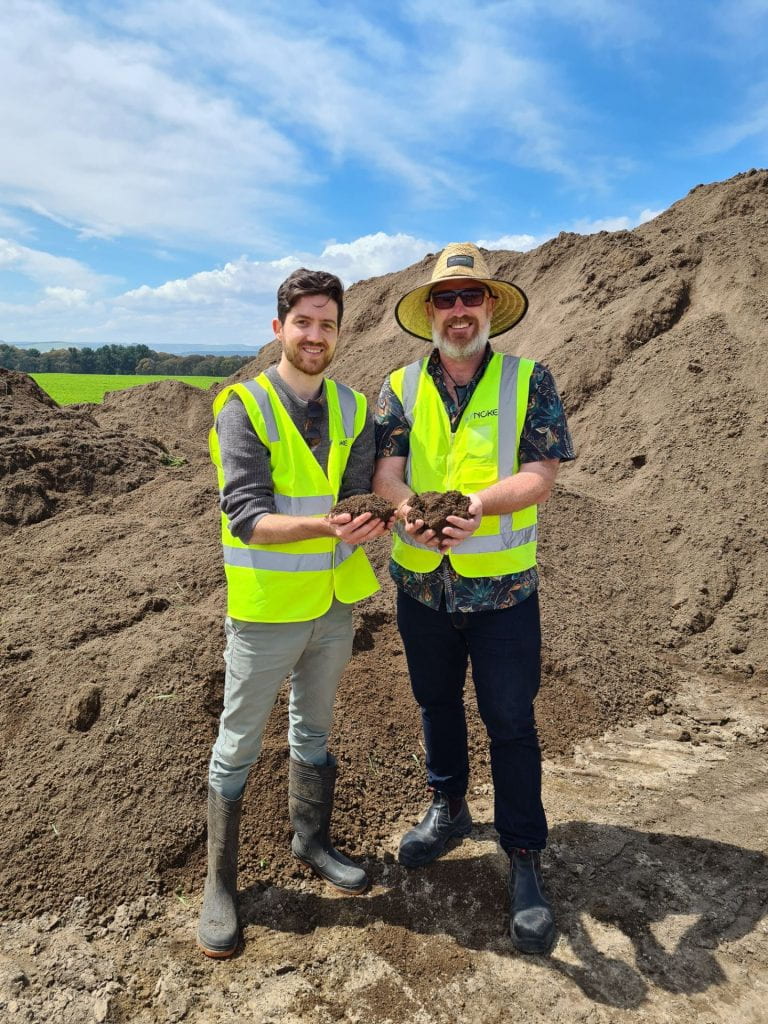
OPMCSA staff member Jacques with MyNoke’s General Manager Phil Holland standing in front of a freshly
harvested pile of vermicast at MyNoke’s Taupō site.
Anaerobic digestion
How does it work?
Food waste is broken down by microbes in the absence of oxygen. The methane (and small amount of CO2) that the microbes produce, known as biogas, can be burnt to generate heat and electricity, or upgraded to serve as a substitute for natural gas. The wet mixture of solid and liquid residue that remains after methane is extracted is called digestate and can be used as a fertiliser. Further processing of digestate can make it more suitable for use, with a wide range of options available such as composting, vermicomposting, and pyrolysis.
Anaerobic digestion is a well-established process. While it is new to Aotearoa for food waste processing (we currently have one facility in Reporoa managed by EcoGas, which opened in 2022), it has been used here for many years to process biosolids, manure, and industrial effluent (especially from the dairy industry). Anaerobic digestion main feedstocks overseas vary; for example, facilities in Germany mostly process pig manure and crop residues from its many farms, while in the UK over half of the organic material processed by anaerobic digestion plants is food waste, crop waste, and other waste streams.
In 2019, John Campbell interviewed Ecogas director Andrew Fischer about the company’s plans to establish an anaerobic digestion facility in Reporoa. The facility was officially opened in 2022 and will be processing all of Auckland’s household food scraps when the collection service is rolled out across the supercity in 2023.
Anaerobic digestion: inputs, process, outputs
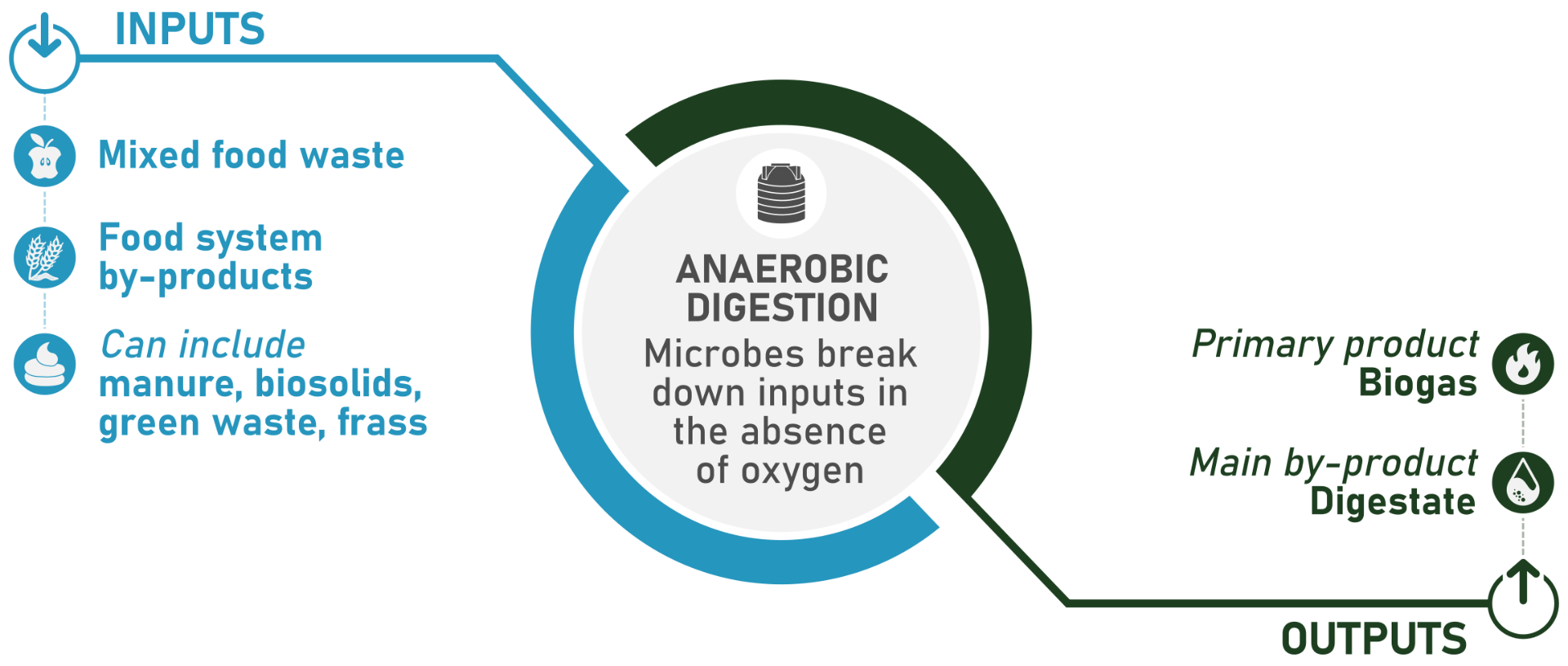
Infographic showing the main inputs and outputs of anaerobic digestion. A wide variety of inputs are possible – anaerobic digestion of dairy by-products and biosolids is an established practice in Aotearoa, while anaerobic digestion of food waste is new to the country. The process relies on the exclusion of oxygen so that the inputs break down anaerobically, producing methane-rich biogas that can be used to generate heat and electricity, or as a replacement for natural gas. Digestate is the primary by-product. Depending on the inputs (and their contaminant loading), digestate can be used as a fertiliser directly or with further processing. Note, while some anaerobic digestion systems can process green waste, it is typically does not aid the efficient production of biogas.
Key benefits
- Anaerobic digestion facilities can be carbon neutral or carbon negative when biogas or its purified form, biomethane, is used as a substitute for fossil fuels to produce electricity, heat, or transport, and when digestate is used to displace fertiliser.
- Anaerobic digestion facilities are fully contained. This means that, unlike landfills with gas capture, they recover almost all the methane produced. Containment also reduces odour risks meaning anaerobic digestors can be situated closer to major population bases than many other food waste processing options.
- Can process a wide range of organic waste types including mixed food waste, crop residues, biosolids, manure, and industrial effluent.
- Potential to use the generated carbon dioxide (CO2) in greenhouses and elsewhere (e.g. as food grade CO2).
- Where inputs and processes are properly regulated, digestate can be used as a fertiliser in agricultural settings
Key challenges and risks to mitigate
- Requires significant investment in infrastructure to capture and process the methane from organic waste.
- Biogas needs to be purified (removing the CO2, water vapour, and trace gases) before it can be readily used as a natural gas substitute.
- Application of digestate to land needs to be done with care, and more research on its use in agronomic settings is needed. Excessive application of digestate can harm plants, leach excess nitrate, and produce odours (mostly from ammonia) and greenhouse gas emissions.
- Controlling for the quality of feedstocks from residential or urban organic waste streams can be a challenge, with potential knock-on effects for digestate quality.
Case study: Anaerobic digestion with Ecogas
Ecogas is a New Zealand-based company which specialises in the anaerobic digestion (AD) of organic waste from households and businesses. Food waste is used to generate biogas (a fuel source) and digestate (a potential fertiliser). Ecogas, a partnership between Pioneer Energy and Eco Stock Supplies, is new to the AD scene in New Zealand, having recently opened their flagship facility in Reporoa in mid-2022.
Once fully operational, Ecogas plans to process 75,000 tonnes of organic waste at its Reporoa facility – including a mix of household food scraps, commercial and retail food waste, and dairy waste – producing biogas and digestate from these feedstocks. Kerbside food scraps from Auckland as set to make up for 38,000 tonnes of Ecogas’ feedstock as collections is rolled out during 2023. After being collected, this household food waste will be consolidated in Ecogas’ sorting and consolidation centre in Papakura, and then sent to the Reporoa Organics Processing Facility using freight trucks that otherwise would have been empty on their return journey from Auckland to Reporoa. There it will be separated from contaminants like plastic, biodegradable packaging, and metal prior to processing in anaerobic digesters.
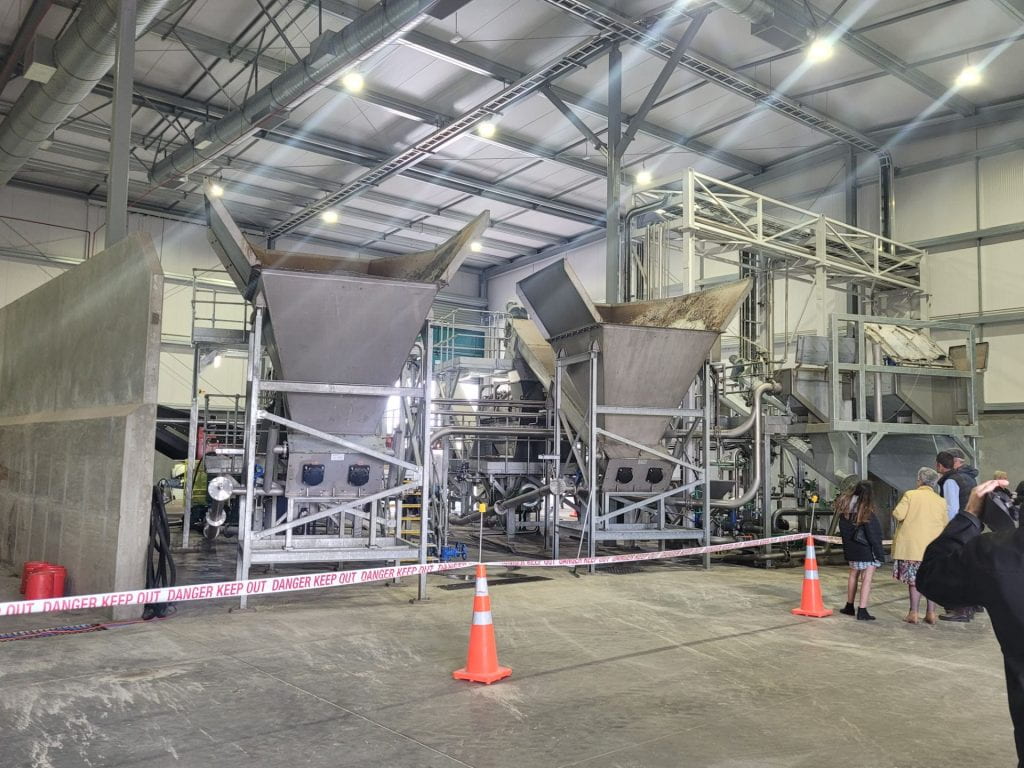
Sorting hoppers which receive and filter organic waste streams at Ecogas’ Reporoa plant.
Biogas, the primary product of AD, is a mixture of methane, CO2, and small quantities of other gases. To create biogas, feedstock at Ecogas’ Reporoa facility is machine-sorted, passed through a grinder, and fed into large airtight tanks, where microbes are used to break down organic matter in the absence of oxygen, releasing biogas in the process. Biogas is siphoned out of the top of digestion tanks whereafter it is conditioned (cleaned to remove unwanted sulphur compounds and moisture) and stored for use. Biogas can be used in place of virgin natural gas, providing energy without the environmental tolls associated with natural gas extraction. Concurrently, biogas produced from food waste mitigates methane emissions that would otherwise occur if waste was sent to landfill. Presently, Ecogas generates electricity and heat for their Reporoa facility by burning a portion of the biogas produced on site. Once fully operational, Ecogas plans to send the heat and CO2 from biogas to a local tomato glasshouse to improve growing conditions. Looking forward, Ecogas plans to upgrade the biogas it produces into biomethane to inject into the natural gas grid.
Beyond biogas, the AD process also produces digestate, a wet mixture of processed solids and water. Where digestate is primarily derived from food waste – as is the case for Ecogas – it typically contains high levels of nutrients like nitrogen, phosphorous, and potassium, minerals and trace elements. Given that most of the carbon in the feedstock is converted into biogas, digestate contains little carbon relative to other soil amendment products like compost. At Ecogas, digestate will be pasteurised before being sent to farmers as an alternative to mineral fertilisers. This is a common practice in several European countries, as well as parts of North America and Asia. To help inform the introduction of digestate on the New Zealand farming market, Ecogas has run trials with digestate from at a small pilot plant in Wiri to compare the effects of digestate on pasture growth with common fertilisers and soil treatments, although results aren’t yet available. In addition, Ecogas, in partnership with the Bioenergy Association, is working on an industry-lead set of standards for digestate use and certification in New Zealand. This is a key step in ensuring that there are end markets for digestate, especially as it is currently considered a waste product in New Zealand. Ecogas’ approach to these standards seeks to mirror initiatives abroad (e.g. the PAS110 in the UK and the SPCR 120 in Sweden) which control digestate quality and minimise any potential adverse effects of its application.
Ecogas currently provides fulltime employment for seven people, which will potentially increase to 10–15 as capacity at Reporoa increases. Ecogas plans to expand its operations in Aotearoa in the future, with discussions ongoing for new facilities in Canterbury and Manawatu in the next five years.
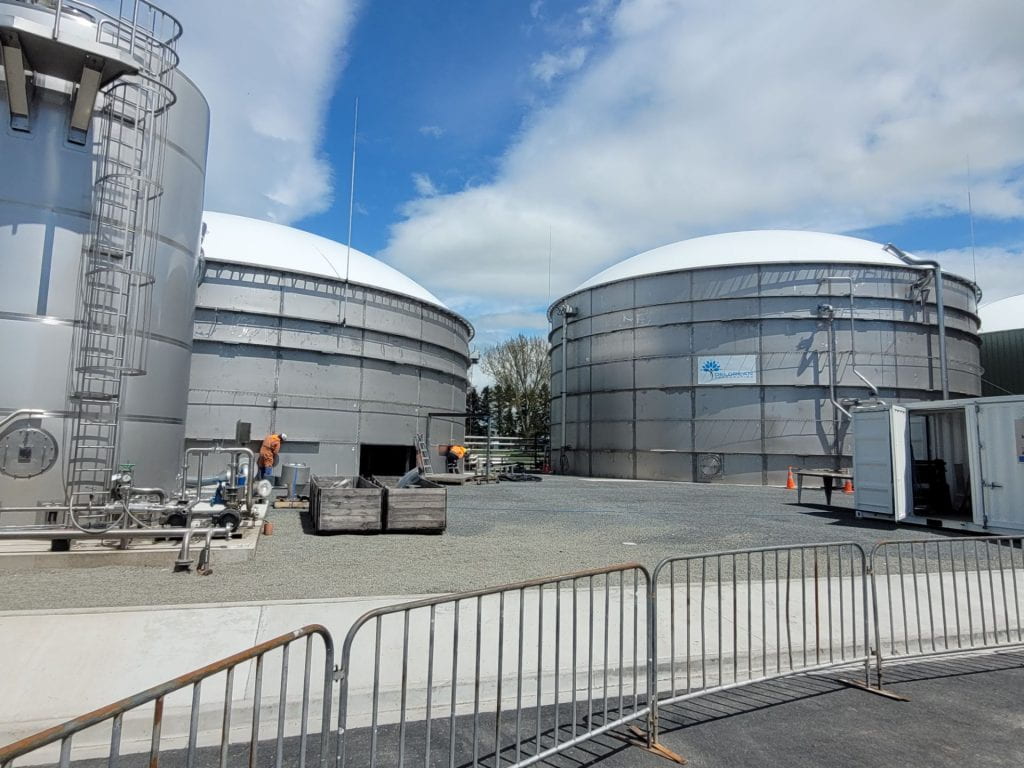
The digester tanks at Reporoa which hold up to 3,500,000 litres of organic waste. Methane rises to the top of the tanks
and are captured using a hose system.
Pyrolysis and gasification
How does it work?
Pyrolysis and gasification are two similar processes for converting food waste to biochar and energy. Food waste is partially combusted in the absence of oxygen (in the case of pyrolysis) or presence of a limited amount of oxygen (in the case of gasification). Instead of reducing food waste to ash and heat energy (as is the case with incineration), pyrolysis and gasification of organic materials produces biochar, a solid, carbon-rich product that can store carbon for centuries, improve soils, and remove pollutants or toxins from the environment. In addition, syngas (produced by both pyrolysis and gasification) and bio-oil (produced by pyrolysis) can be used as energy sources.
Pyrolysis and gasification are well-established processes for some feedstocks but have only recently started to be used for organic waste, especially mixed food waste. Here we focus on the use of these processes for organic material processing only; where other feedstocks are used (e.g. municipal solid waste), the outputs vary, and the acceptable uses of those outputs become constrained. For example, if municipal solid waste is used, the solid product is called char (rather than biochar) and must be disposed of to landfill.
While biochar, bio-oil, and syngas have many uses, it’s important to note that the nutrients in food waste are lost during pyrolysis and gasification, so these processes sit towards the bottom of the food waste hierarchy and run counter to the principles of the circular economy*. The Ministry for the Environment has produced a useful waste to energy guide for New Zealand, which deals with these topics and other key considerations such as the risk that waste to energy investments will undermine resource recovery efforts and source prevention of waste.
Use of these processes for organic material processing in Aotearoa is largely limited to demonstration and pilot scale operations.
___________________________
*Importantly, pyrolysis can help “close the loop” for some difficult-to-manage waste streams beyond household food scraps. The role and context in which pyrolysis can support the principles of a circular economy will be discussed further in our forthcoming report on capturing value from food waste.
Pyrolysis: inputs, process, outputs
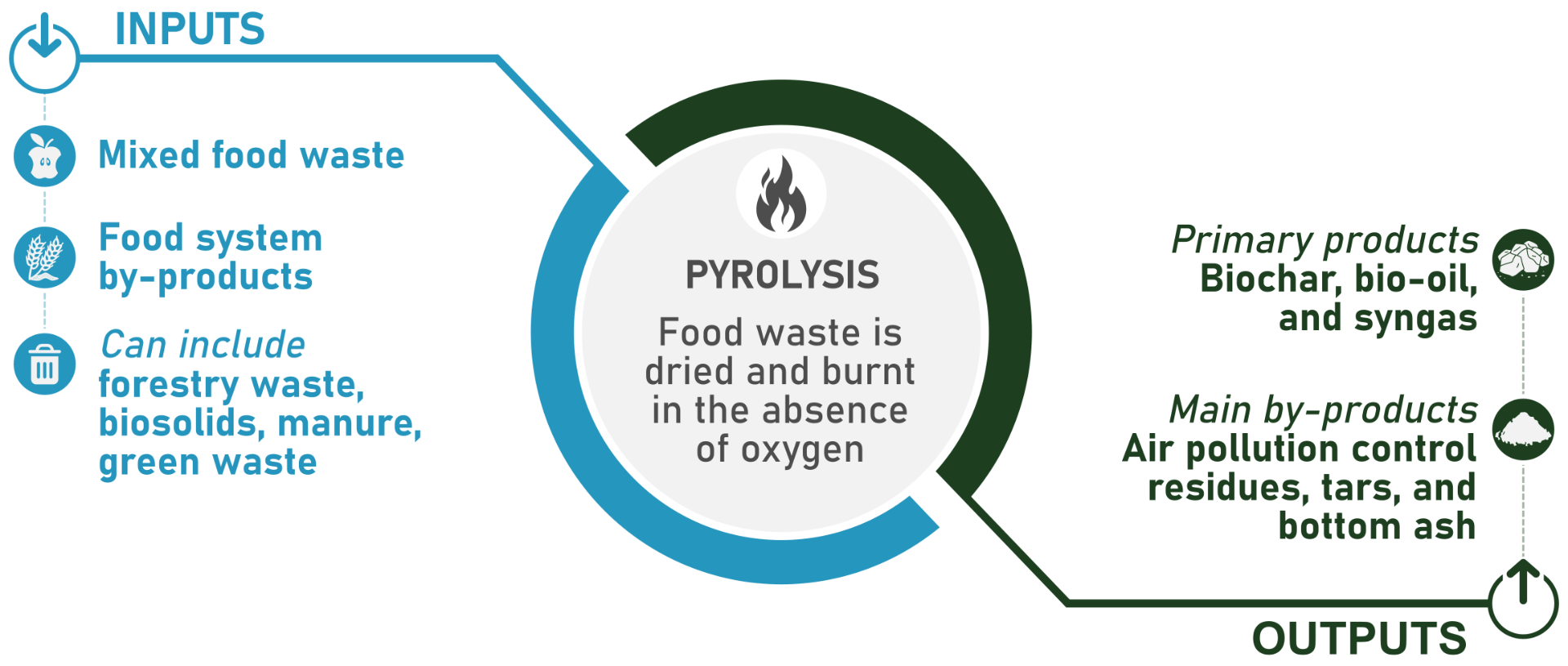
Infographic showing the main inputs and outputs of pyrolysis, a thermochemical processing option for food waste. Pyrolysis must take place in the absence of oxygen and at high temperatures. While inputs can theoretically include inorganic municipal solid waste as well, this impacts the quality and potential uses of the resulting char, making it unsuitable for use as a soil amendment or for environmental remediation. Syngas and bio-oil are also produced when food waste is pyrolysed, energy products which are largely or entirely consumed by the energy demands of the process itself. By-products include air pollution control residues, tars, and bottom ash, all of which need to be managed, including treatment of air pollution control residues as a hazardous waste.
Gasification: inputs, process, outputs
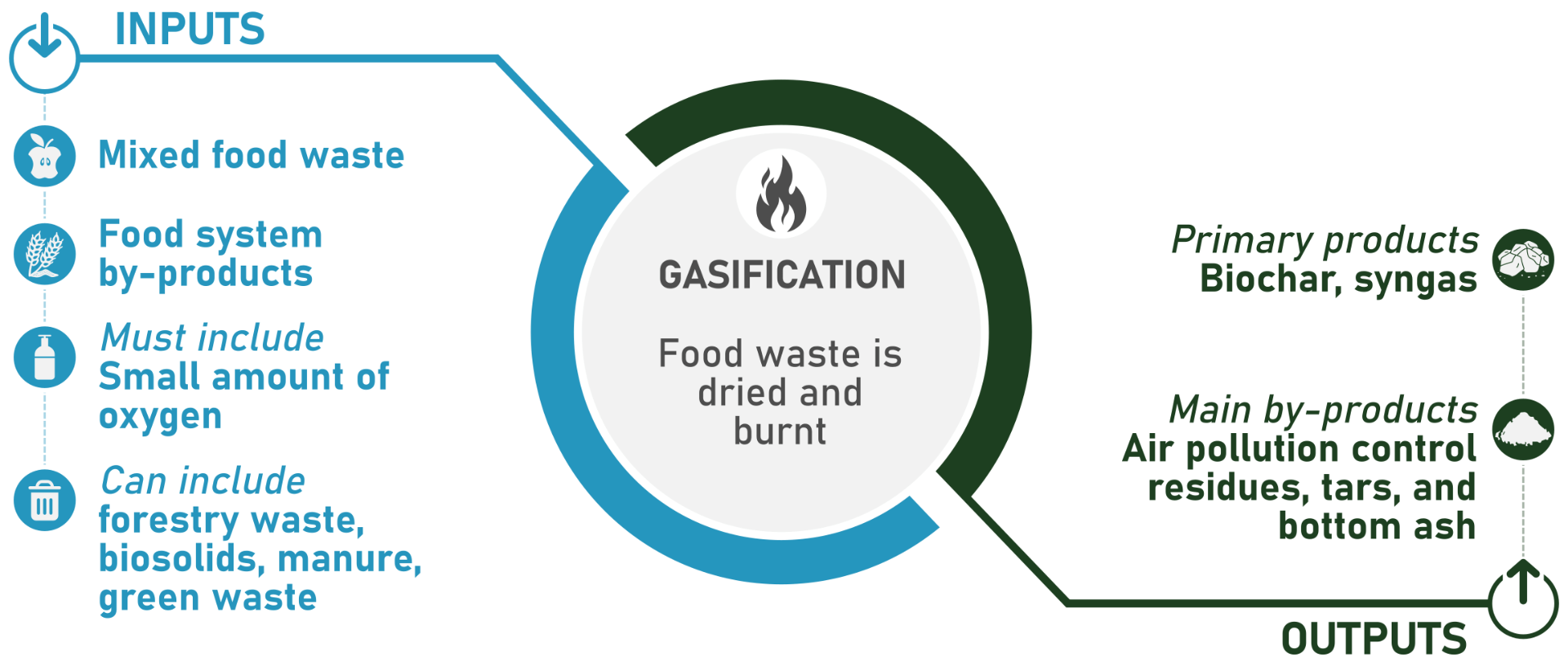
Infographic showing the main inputs and outputs of gasification, a thermochemical processing option for food waste. Gasification is much the same as pyrolysis, but a small amount of oxygen is let into the system, which means bio-oil isn’t produced.
Key benefits
- Biochar can sequester carbon for centuries because the carbon in biochar exists in a stable form which lasts for a lot longer than untreated food waste.
- Biochar can also be used a fertiliser replacement or complement, improving availability of nutrients, making soils better at retaining moisture, and improving soil chemistry. Evidence also suggests it can be used to improve the efficiency of composting and anaerobic digestion, and the quality of products from these processes.
- Biochar can be used to remediate soils and waterways because it can adsorb things like heavy metals and persistent organic pollutants. It can also control odours.
Key challenges and risks to mitigate
- The quality and properties of the biochar depend heavily on what is fed into the process and, if contaminants are present, it might not be suitable to apply to land.
- A lot of energy is consumed when food waste is dried to an acceptably low moisture level (ideally less than 25% or even as low as 10%). This means that the amount of energy used in the process is equal to or greater than the amount of energy available from the syngas that is produced. Energy is also expended when the feedstock is chopped into small pieces (which is necessary to ensure rapid heat transfer).
- While bio-oil has the potential to be used as a diesel- or petrol-like fuel, it generally requires upgrading – often it can contain too much water to combust efficiently and could cause engine rusting.
- While air pollution can be kept in line with air quality regulations by filtering and scrubbing before discharge, this creates contaminated wet scrubber wastewater which needs careful disposal. Some of the pollutants produced are toxic and environmentally persistent.
Case study: Pyrocal, an Australian gasification company
Queensland-based Pyrocal is an Australian company that specialises in the gasification of residual waste. Pyrocal began developing its technology in 2008, and its flagship project started operating in 2022 – a gasification facility in Loganholme that processes biosolids produced at the Logan City wastewater treatment plant.
Instead of spreading biosolids on agricultural land, as was the city’s previous practice, biosolids are gasified at the wastewater treatment plant. Land spreading of biosolids is receiving increasing scrutiny in Australia given the introduction of PFAS to soil, a persistent organic pollutant which is reportedly broken down by Pyrocal’s gasification technology, as well as the transport emissions accrued when biosolids produced in cities are transported to rural areas.
Because biosolids are so wet, requiring energy-intensive drying before gasification, the process is energy neutral, with no surplus energy being produced. However, gasification reduces the volume of biosolid waste by up to 90% and produces biochar which can be partly or fully recovered, depending on the waste feedstock and char composition. The biochar can be applied to soil, stably sequestering carbon and serving as a soil conditioner. Given its adsorptive properties, biochar also has applications in environmental remediation and as a stockfeed. Pyrocal also gasifies agricultural and forestry residues which, in Loganholme, it uses to get the gasification system up to temperature before processing biosolids.
In addition to its operational facility in Loganholme, Pyrocal has a facility in Wellcamp, where it is developing knowledge about the use of its gasification technology for other feedstocks, including food and green waste.
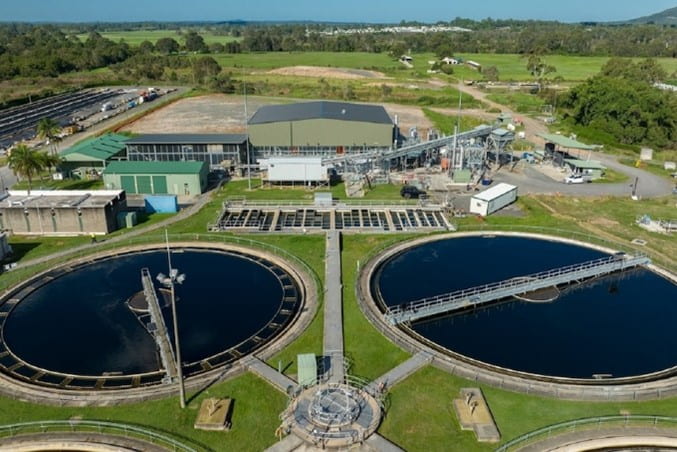
Pyrocal’s gasification facility at Loganholme (background) next to two wastewater treatment
ponds (foreground). Image credit: Pyrocal.
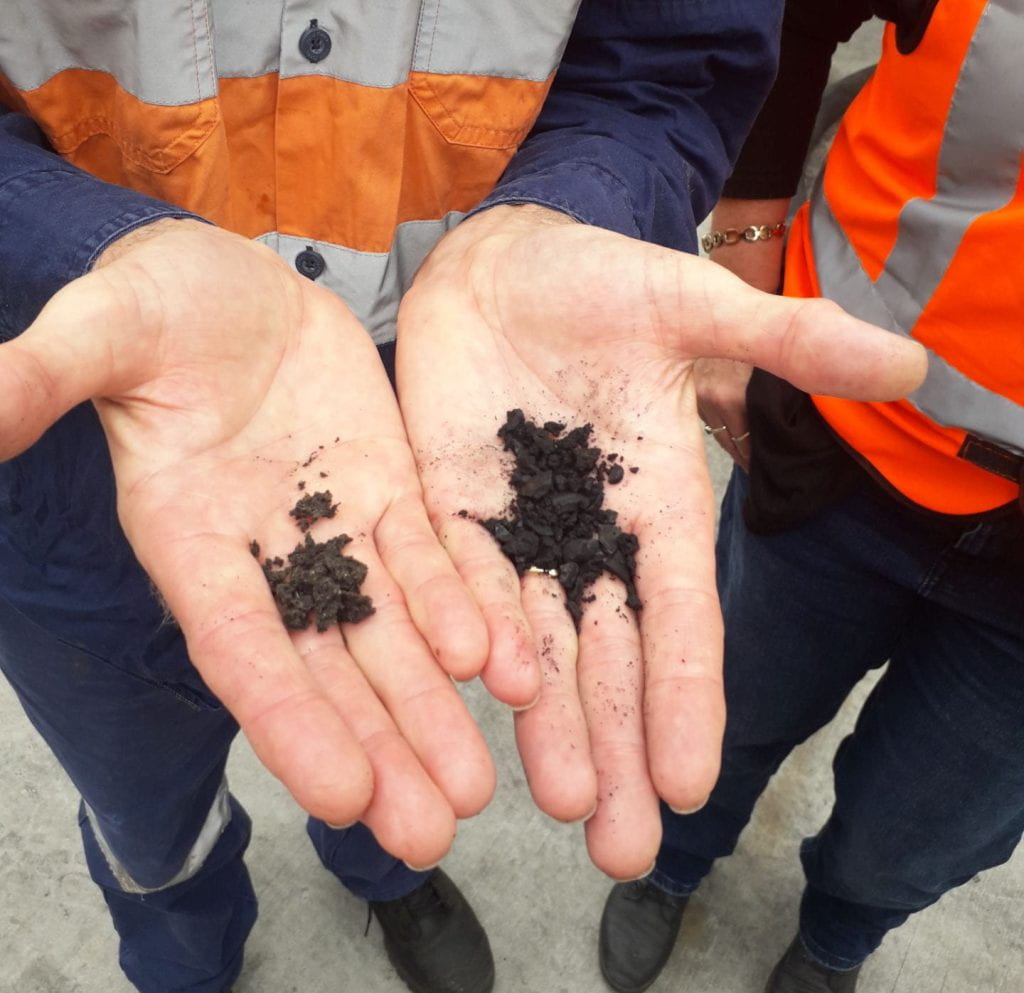
Biosolids from wastewater treatment following drying (left) and gasification (right).
Pyrocal also undertakes projects exploring the properties and performance of its biochar, including contributing to a recent project with Dubbo Regional Council where it was found that biochar, used as part of a rock pit tree planting system, contributed to enhanced tree growth and reduced need for watering given its water retention and cation exchange properties.
The most complicated part of Pyrocal’s process is air pollution control. It must make sure that particulate matter, sulfur dioxide, nitrous oxide, and other emissions are kept within legal limits. Continuous emissions monitoring and full air emissions analysis during trials enabled Pyrocal’s air pollution control processes to be finetuned to ensure compliance while also improving energy efficiency. The water used in the process of air pollution control is used to quench biochar before being returned to wastewater treatment ponds, and the small amount of soot produced by the system (approximately 200 kg per year) is disposed of as general waste.
Pyrocal sells carbon credits based on biochar produced from nutshells and wood waste on voluntary carbon markets. This is facilitated by Puro.earth, a carbon crediting programme specifically focused on credits for engineered carbon removal and long-term sequestration. Selling independently verified carbon credits on voluntary markets provides an additional revenue stream on top of waste processing fees and biochar sales.
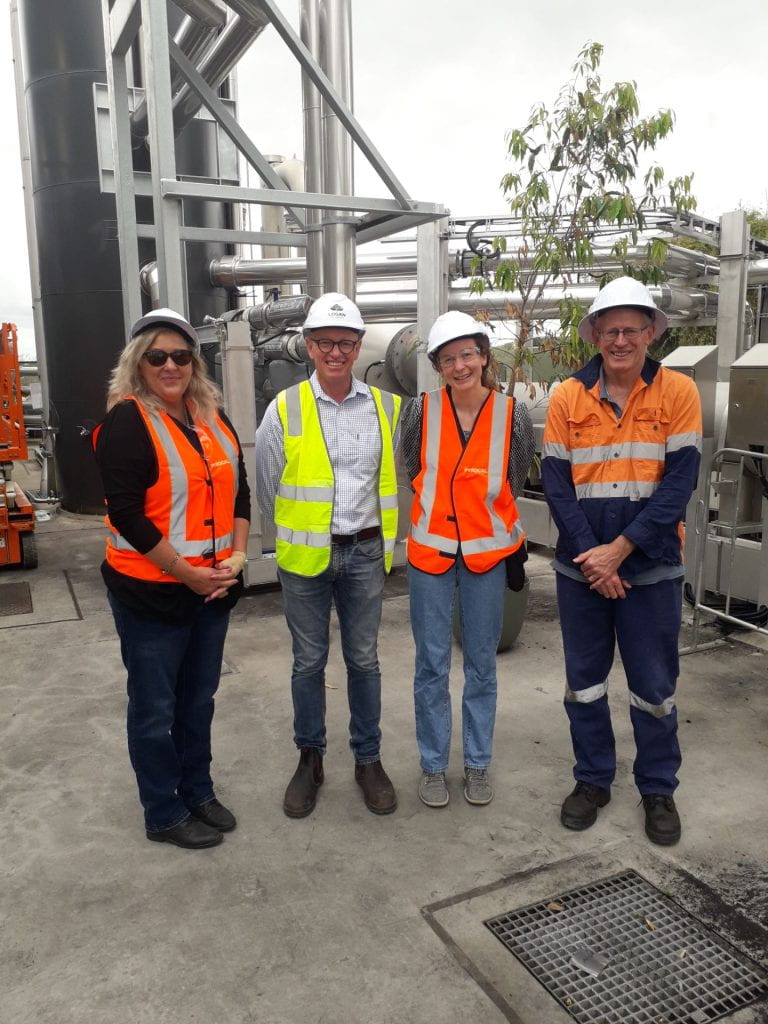
OPMCSA staff member Emily with Pyrocal’s Cherie Pugh (manager) and Durell Hammond (director), and Downer’s
Mark Newland (principal process design engineer) following a tour of the Pyrocal gasification plant at Logan Water.
Date released: 29 March 2023
Last updated: 12 April 2023
